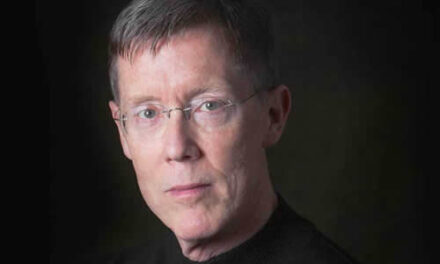The epic Gilgamesh is an ancient story dating back to Sumerian culture somewhere between 2750 and 2500 B.C. Here, today, we “finally” have a production of the story using the Diana Wortham Theatre and the media of music, dance, and theater, an epic all by itself. The text is by modern playwright David Brendan Hopes with original music by Matthew Richmond and choreography by Ann Dunn. All of this was pulled together under a heinous schedule with help from Director Michael MacCauley and Lighting Designer Ardean Landuis. Says Hopes, “I began writing it last winter (‘05/‘06), mostly in response to my amazement that it had not been done before. The music didn’t exist five months ago; Dunn’s brain was working on the dance concepts as much as a year ago. (Ed. note: There is an oratorio by Martinu – The Epic of Gilgamesh – that some readers may recall from recordings).
If you look at the roots of this thing, not much has changed in 4,700 years. To me it portrays all of the human travails of power, lust, love, life, death, mine’s bigger than yours, no it’s not, etc. However, to history buffs or more cultured/educated citizens there may be deeper truths or allegories to feast upon. Yet I tend to view the plane of life’s rich pageantry as a closed loop of self-perpetuating ignorance. Only the clothes and technology change. As Professor Peter Schickele says, “You can’t have opinions about truth, Truth is just truth!”
We’re working with an historical king of Uruk in Babylonia, roughly on the River Euphrates in modern Iraq. Basically, civilizations of the Tigris-Euphrates area were among the first civilizations and used the exploits of Gilgamesh as a reflection of their existence. Many stories and myths were written about Gilgamesh in the Sumerian language on clay tablets that survive to this day. You are reading this on-line, so it would be a snap to search using the title and get the more detailed story.
The strongest elements of this production were, without question, the original music and choreography. The next tier worthy of mention is costumes and lighting. The acting side suffered, probably because this production only came together one week before the premiere but also due to lack of sufficient experience to pull off such a large and old concept while using college students. The UNCA Black Swan Theater was established in 1988 as an extension of the English department’s Creative Writing Program, so … you know. I have shoes older than some of these people.
Asheville–based composer Matthew Richmond deserves a nod for such a wonderful score. Instrumentation is based heavily in percussion and voice while using the occasional keyboard–generated sound for accent. Perhaps most striking were the glass harmonica sound, and the crisply–articulated voices of Cantaria under the expert direction of Michael Porter.* You could also hear the marimba, various “phones” and a rain stick. The composer borrowed, used, or was influenced by Sumerian numerology during the composition process. This had an effect on things like time signatures, intervals and pitch duration. A recording will be available soon. Watch this space for news!
The other great news is Ann Dunn was turned loose on the dance component. As usual, she generated a spacious, colorful and elegant panorama for the stage. Her usual troupe of dancers snapped up the parts and – regardless of role – delivered a terribly professional series of scenes. Dunn always seems to program one floor piece (or crawler) for solo dancer. This time it was a stage-front left–to–right passacaglia for female that ended in a sensual embrace. At some point while observing Dunn’s work you’ll need to go outside to cool off.
The performance was supported in part by a grant from the Asheville Area Arts Council with Grassroots funds from the North Carolina State Arts Council. Well spent, but likely we won’t see the work again unless it turns up on video. I will certainly get back to you about the soundtrack CD. That will be something to have.
*A followup up note from the composer. “The bulk of the choir was actually the UNCA University Singers, directed by Melodie Galloway, and Melodie was also the primary performance conductor. The whole vocal element really came together at the last minute, after we had created promotional materials listing Cantaria alone.”











